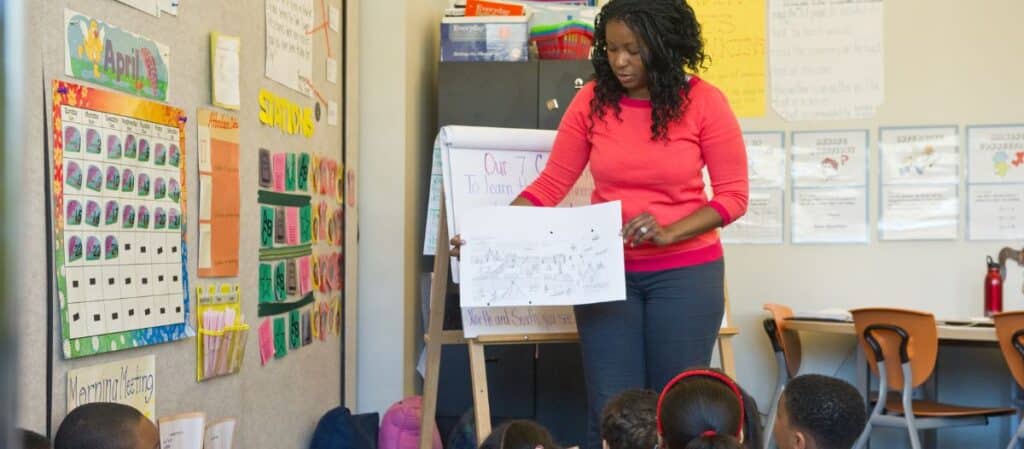Interactive Modeling is a straightforward and effective technique for showing students exactly how to meet expectations for any routine or skill that needs to be done in one specific way. You can use Interactive Modeling for school and classroom routines such as responding to a signal and walking in line, and it is an equally powerful tool for teaching academic skills. The technique’s combination of modeling, noticing, and reinforcing gives students a clear mental image of the academic behavior, helps them notice important details about it, and immediately gives them opportunities to practice and receive teacher feedback.
For developmental reasons, the steps for Interactive Modeling are different in elementary school and middle school (you can find steps for both age levels here), but the overall principles remain the same. When implementing Interactive Modeling to support students in an academic endeavor, remember to make a plan, keep instructions straightforward, and follow up with productive feedback.
Make a Plan
Interactive Modeling works best when you prepare beforehand by considering these questions:
- What specifically do I want my students to learn and practice? Reflecting on this question might lead you to the conclusion that a different strategy is more effective for the particular academic segment you are considering, especially if you are struggling to make the skill or concept specific enough to model.
- What do I want my students to notice while I model? Deciding beforehand what you want students to notice ensures that students will have all the information they need to successfully practice. This also helps you catch if students are missing an important element of the modeling. If they do miss something, direct their attention directly to the element they are missing, rather than making it a guessing game: “What did you see me do before I used the ruler?”
- What language can I use to reinforce students during practice? Brainstorming language in advance will help you provide effective feedback in the moment. In place of generic statements like “Good job making patterns,” you can target the focus of the Interactive Modeling: “I am noticing people switching colors to create AB patterns.”
Keep It Straightforward
Use Interactive Modeling to teach an academic skill or concept in which there is one way you want students to demonstrate their learning. Choose something that students will understand when they see you model it and something you can provide clear feedback about when it is the students’ turn to practice. When choosing the focus of your Interactive Modeling, here are three things to keep in mind:
- Choose a skill with a clear focus. The focus of your Interactive Modeling will be something you want all students to do the same way; modeling something open-ended won’t work. For example, modeling for students how to create an AB pattern will be much more successful than modeling how to create a pattern in general.
- Avoid modeling multistep skills. Similarly, modeling a multistep process will not set students up for success. For example, trying to teach students long division using Interactive Modeling will invariably leave them frustrated or overwhelmed. Modeling a strategy for how to appropriately align digits to multiply two large numbers, however, is a specific enough focus that students can understand it when they see it modeled, practice it independently, and receive productive feedback.
- Make sure learning doesn’t get lost in the process of modeling. Sometimes when Interactive Modeling focuses on a strategy for how to learn, students can get too focused on that strategy at the expense of actual learning. For example, let’s say you decide to use Interactive Modeling to teach your students how to do a Museum Walk to learn more about photosynthesis. When it’s time to practice the Museum Walk, you notice that getting all the steps of the Museum Walk right is more of a priority for students than learning about photosynthesis. This is why it is important to figure out what learning you want to prioritize and to remove other, less important, steps from what you are modeling.
Follow Up With Productive Feedback
The final step of the elementary school version of Interactive Modeling is to “provide feedback,” while the final step of the middle school version is to “reinforce students’ practice with immediate feedback.” There is a reason both versions end on such similar steps: using reinforcing language to let students know the ways they were successful in practicing what they saw modeled is what helps them solidify their learning. Effective feedback sets students up to be more successful the next time you ask them to perform the same academic strategy in the future.
Here are some sentence stems you can use to make productive feedback a key characteristic of your teacher language during Interactive Modeling:
- “I’m noticing that we all remembered to . . .”
- “Practicing the strategy this way really helped you be successful with . . .”
- “I see that we remembered how to thoughtfully . . .”
- “The way you did___ really helped you___.”
- “You were able to successfully ___ because ___.”
- “You demonstrated ___ exactly the way that it was modeled.”
Further Resources
When Interactive Modeling is planned in advance, has an appropriate focus, and offers students effective feedback, it can be a powerful tool for helping students actively engage in learning and attain success with academic skills and concepts. Get started with your planning today with our Interactive Modeling Planning Guides for elementary school and middle school. Or learn more about how you can use Interactive Modeling in your classroom with Interactive Modeling, The Language of Learning, Make Learning Meaningful, and The Joyful Classroom.
Jane Cofie is the director of curriculum and instruction for Center for Responsive Schools and the author of the book Strengthening the Parent-Teacher Partnership.
